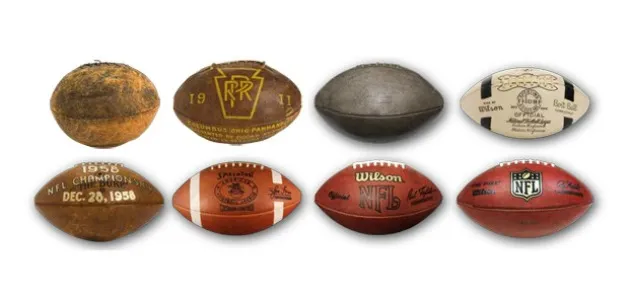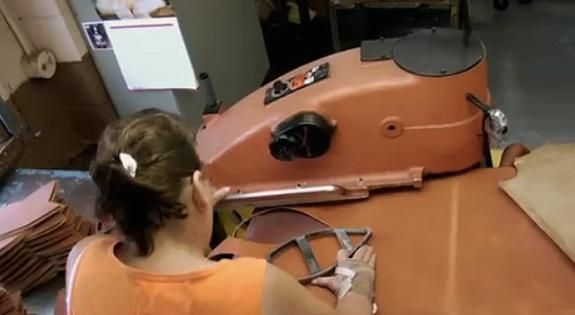How Did the Pigskin Get Its Shape?
American football may have evolved from soccer and rugby, but it turns out that the football was never truly designed, it just sort of happened
/https://tf-cmsv2-smithsonianmag-media.s3.amazonaws.com/filer/3c/e3/3ce3cb3d-04f3-499b-9f81-9f1b30e130f7/football_575.jpg)
The “pigskin” is not made of pig skin but is, in fact, made from cowhide. Of course, popular speculation has it that the leather exterior of the football was once made from the tanned skin of a pig, but it’s more likely that the football was made from a pig’s bladder. We may never know. Equally mysterious is the shape of the ball. If the sport evolved from soccer and rugby, how and when did the football gain its distinct shape – technically known as a prolate spheroid? Well, it turns out that the football was never truly designed, it just sort of happened. According to Henry Duffield, a man who witnessed a game between Princeton and Rutgers in 1869, largely considered to be the first intercollegiate game:
“The ball was not an oval but was supposed to be completely round. It never was, though — it was too hard to blow up right. The game was stopped several times that day while the teams called for a little key from the sidelines. They used it to unlock the small nozzle which was tucked into the ball, and then took turns blowing it up. The last man generally got tired and they put it back in play somewhat lopsided.”
So according to that story, the football that bounces erratically all over a field and can fly through air in a perfect spiral is not, in fact, the product of high design. At least not initially. Rather, it’s the result of a leaky sphere and some lazy inflaters. Initially, football was a very different game – or perhaps I should say games. There were kicking games and running games, but as those two games began to merge together, as rules began to standardize, the ball began to slightly stretch out in order to accommodate more types of use. The unique shape of the ball was somewhat formalized in the early 20th century and that form was exploited to great success when the forward pass was introduced to football in 1906.

As the game continued to change, the ball evolved to accommodate new rules and new plays. Most notably, in the 1930s, it became longer and slimmer as the forward pass became a more dominant–and more encouraged–part of the game. Another change came in 1956 when the white balls traditionally used in night games were replaced with a standard daytime football circled by two white stripes. Though advancements in stadium lighting have made night balls unnecessary, NCAA games still use the white-striped ball.
In 1941, the official football used by the NFL was nicknamed “The Duke,” after the Wellington Mara, whose father named him after the Duke of Wellington. That name played a key role in establishing the relationship between the NFL and Wilson Sporting Goods, the company that has for more than 70 years produced the offical football of the NFL. “The Duke” was in play until 1969 when professional football reorganized. In 2006, National Football League owners decided to return the name of the official game ball to “The Duke” in honor of Wellington Mara’s passing the previous year.

Today, in order to be used in a National Football League game, a football must meet the following requirements: It shall consist of a urethane bladder inflated to 12.5 to 13.5 pounds and enclosed in a pebble grained, tan leather outer shell designed to provide a good grip – even in the rain. The ball must be 11-11.25 inches long, have a long circumference between 28- 28.5 inches, a short circumference between 21-21.25 inches; and it must weigh 14 to 15 ounces. The variation in the measurements is due to the fact that all NFL footballs are made by hand. Since 1955 every NFL football has been made at Wilson’s 130-person factory in Ada, Ohio, which produces up to 4,000 footballs a day.
These NFL footballs are born on the backs of Midwestern cows from Iowa, Kansas, and Nebraska, which are brought to a tannery in Ada and treated with a top secret football-weather-optimizing tanning recipe. Each football is composed of four separate pieces (see above image), with a single cowhide producing ten balls. The construction of the bladder is also a secret process, with each synthetic bladder produced by one man. From pigskin to cowhide, organic bladder to synthetic rubber, the ball has changed and the game itself has evolved into a completely different animal.
/https://tf-cmsv2-smithsonianmag-media.s3.amazonaws.com/accounts/headshot/Jimmy-Stamp-240.jpg)
/https://tf-cmsv2-smithsonianmag-media.s3.amazonaws.com/accounts/headshot/Jimmy-Stamp-240.jpg)